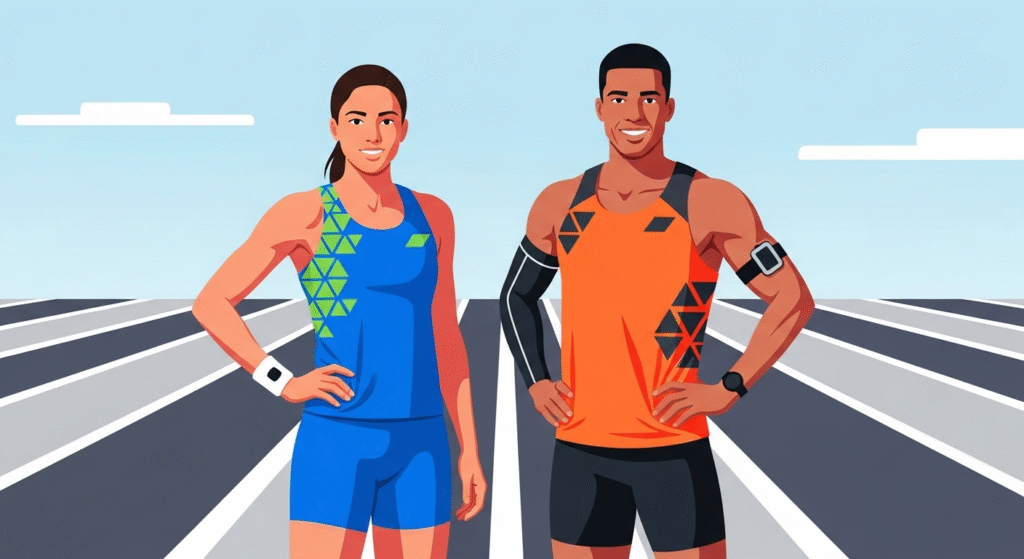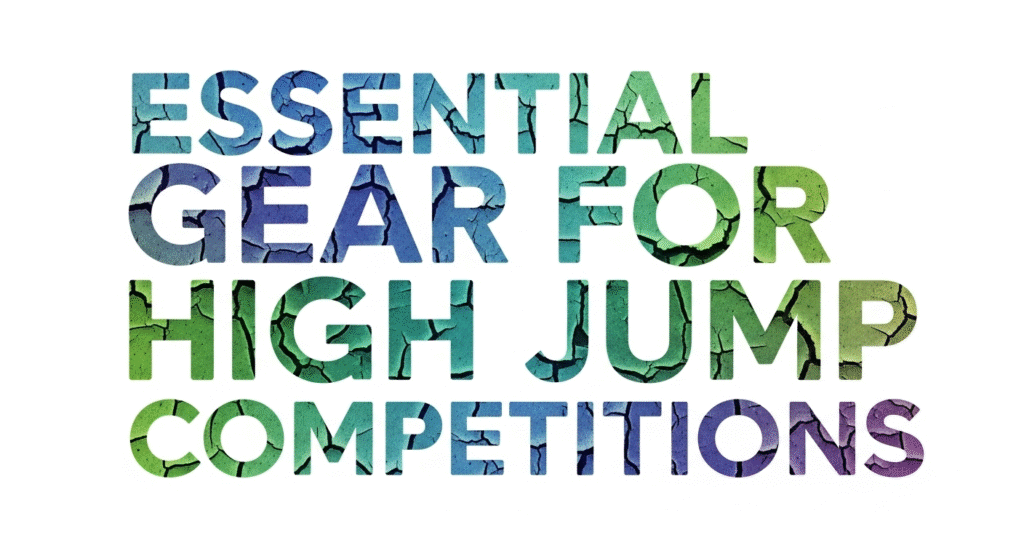Gear for High Jump Competitions: Introduction
Competing in high jump events requires not only skill and athleticism but also the right equipment to maximize performance and ensure safety. Selecting the appropriate gear can make a significant difference in an athlete’s ability to achieve personal bests and excel in competitions. This comprehensive guide explores the essential gear for high jump competitions, helping athletes make informed choices about clothing, shoes, and performance tools that align with professional standards.
Whether you’re a novice jumper preparing for your first competition or a seasoned athlete looking to upgrade your equipment, understanding the nuances of high jump gear is crucial for success. The right combination of footwear, apparel, and accessories can provide the confidence and technical advantage needed to clear greater heights. Let’s dive into the essential components of high jump competition gear that can elevate your performance to new heights.
Gear for High Jump Competitions: High-Performance Footwear
Footwear is arguably the most critical piece of equipment in high jump, providing the necessary support, traction, and flexibility to excel. The specialized design of high jump spikes can significantly impact an athlete’s approach speed, take-off power, and overall jumping mechanics.
High jump spikes differ considerably from running shoes or even other track and field footwear. They feature a reinforced heel area that provides crucial support during the plant phase of the jump, while the midfoot and forefoot areas remain flexible to allow for proper foot articulation during take-off. The spike plate – typically located at the forefoot – contains 6-9 pins that grip the track surface, giving jumpers the traction needed for a powerful launch.
When selecting high jump spikes for competition, athletes should consider several factors beyond just fit. The spike length should comply with competition regulations (usually 6-9mm) while providing optimal grip for your jumping style and the surface you’ll be competing on. Some venues may have restrictions on spike types, so it’s always wise to check the competition guidelines beforehand.
The weight of your spikes also plays a crucial role in performance. Modern high jump shoes typically weigh between 200-300 grams, striking a balance between durability and lightness. Lighter shoes can help increase jump height by reducing the weight athletes need to lift during the jump, but they shouldn’t sacrifice structural integrity that provides essential support.
Professional high jumpers often have different pairs of spikes for training and competition. Competition spikes tend to be lighter and more responsive, while training pairs are built for durability to withstand repeated practice sessions. This approach helps extend the life of your competition footwear while ensuring you always have the best performance gear when it counts most.
- Choose spikes that offer optimal grip without sacrificing comfort. Look for models with replaceable spikes that allow you to adjust based on track conditions.
- Ensure shoes are lightweight to enhance jump height and speed. Many elite jumpers prefer shoes weighing under 250 grams for competition day.
- Look for durability to withstand repeated landings and take-offs. Quality materials like reinforced synthetic leather can provide longevity without adding unnecessary weight.

Gear for High Jump Competitions: Optimal Jumping Apparel
The right clothing can enhance an athlete’s mobility and comfort, reducing the risk of injury and improving overall performance. While high jump doesn’t require as specialized clothing as some other sports, the nuances of competition apparel can make a substantial difference in an athlete’s experience and results.
Modern high jump apparel utilizes advanced fabric technology designed to work with the athlete’s body through the complex movements of the approach, take-off, and clearance. Materials with four-way stretch capabilities allow for unrestricted movement during the critical moments of the jump. Compression elements in strategic areas can provide support to muscles and improve proprioception – the awareness of body position – which is essential for consistent technique.
Temperature regulation is another crucial aspect of high jump apparel. Competitions can take place in various weather conditions, from hot outdoor meets to climate-controlled indoor facilities. Moisture-wicking fabrics draw sweat away from the body, preventing the discomfort and distraction of damp clothing. This technology helps maintain optimal body temperature regardless of external conditions, allowing athletes to focus entirely on their performance.
When competing at the professional level, many high jumpers opt for singlets or fitted tops that won’t interfere with bar clearance. Loose clothing can catch on the bar during the rotation phase of techniques like the Fosbury Flop, potentially causing failed attempts. Similarly, bottoms should be form-fitting without restricting hip mobility, as the hip flexors play a critical role in generating the power needed for successful jumps.
Layering is an essential strategy for competition day, particularly for outdoor events where conditions can change throughout the day. A warm-up suit made from lightweight, breathable materials allows athletes to maintain muscle temperature between jumps without overheating. These outer layers should be easy to remove quickly when it’s time to compete, allowing for seamless transitions from warm-up to competition mode.
- Select moisture-wicking fabrics to keep the body dry and cool. Technical polyester blends or nylon-spandex combinations offer ideal properties for high-performance jumping.
- Opt for form-fitting attire that allows a full range of motion. Avoid excess fabric that could catch on the bar or create drag during your approach and clearance.
- Incorporate layered clothing options for warm-up and varying weather conditions. A quality warm-up suit is an investment in consistent performance across different competition environments.
Gear for High Jump Competitions: Essential Performance Accessories
Additional tools and accessories play a vital role in an athlete’s preparation and performance during high jump competitions. These supplementary items might seem minor compared to shoes and clothing, but they can significantly impact an athlete’s confidence, comfort, and technical execution.
Grip enhancement products are particularly valuable for high jumpers, as secure foot placement during the approach and plant phases is critical for generating optimal lift. Many professional jumpers use athletic tape on their take-off foot to prevent slipping and provide additional support. Others prefer liquid chalk or rosin, which can improve grip without the bulk of tape. These products are especially important when competing in humid or rainy conditions where traction becomes more challenging.
Joint support accessories have become increasingly sophisticated, offering targeted compression and stability without restricting natural movement. Ankle supports can provide confidence for athletes with previous injuries, while knee sleeves can help maintain optimal joint temperature and provide proprioceptive feedback during jumps. For high jumpers who experience shin splints or calf issues, graduated compression sleeves can improve blood flow and reduce discomfort during competition.
The integration of technology into high jump training and competition has revolutionized how athletes prepare and perform. Wearable devices that track metrics like approach speed, take-off angle, and bar clearance provide valuable data that can be analyzed to identify areas for improvement. Video analysis tools allow jumpers and coaches to dissect technique frame-by-frame, making subtle adjustments that can lead to significant height improvements.
Competition day essentials extend beyond performance-enhancing gear to include practical items that ensure athlete comfort throughout what can be lengthy events. A dedicated competition bag should contain items like waterproof spike bags, extra spike pins of varying lengths, athletic tape, bandages, skin protectants for areas prone to friction, and personal hygiene products. Many experienced jumpers also pack light snacks and electrolyte drinks to maintain energy levels during extended competitions.
- Use grip-enhancing tape or chalk to prevent slipping during approach. Apply these products strategically to maintain optimal connection with the track surface without creating unnecessary drag.
- Invest in supportive braces or compression sleeves to protect joints and muscles. Modern compression gear provides targeted support while maintaining full range of motion necessary for technical execution.
- Incorporate wearable technology, such as performance trackers, to monitor and improve jumping technique. Data-driven insights can help identify patterns and opportunities for technical refinement that might not be visible to the naked eye.
Gear for High Jump Competitions: Conclusion
Equipping oneself with the right gear is fundamental to success in high jump competitions. By investing in high-performance footwear, optimal jumping apparel, and essential performance accessories, athletes can enhance their performance, reduce the risk of injury, and maintain comfort during competitions. Carefully selecting and maintaining this equipment not only supports an athlete’s current endeavors but also contributes to long-term growth and achievement in the sport of high jumping.
The best performance gear for professional high jump competitions doesn’t necessarily mean the most expensive options on the market. Instead, it’s about finding equipment that complements your individual jumping style, body mechanics, and competitive needs. Taking time to test different options and gathering feedback from coaches and experienced jumpers can help narrow down the choices to find your ideal setup.
As technology continues to advance, we can expect even more sophisticated high jump competition gear essentials to emerge. From footwear with customized spike configurations to smart fabrics that adapt to body temperature and movement patterns, the future of high jump equipment looks promising. However, even with these advancements, the fundamentals remain the same: gear should enhance your natural abilities, not compensate for technical deficiencies.
Ultimately, while having the right equipment is crucial, it’s the athlete’s skill, technique, and mental preparation that determines success in high jump competitions. The best gear provides the foundation upon which technical excellence can be built. By approaching equipment selection with the same dedication and attention to detail that you bring to your training, you’ll be well-positioned to reach new heights in your high jump career.
Coach Otto is a certified track and field coach with over 15 years of experience working with high jumpers at high school, collegiate, and elite levels.

